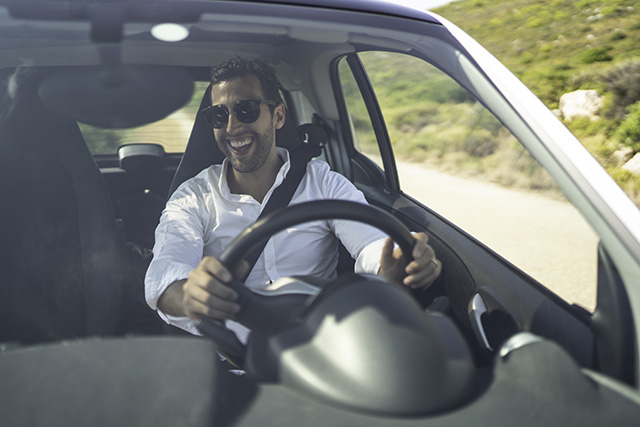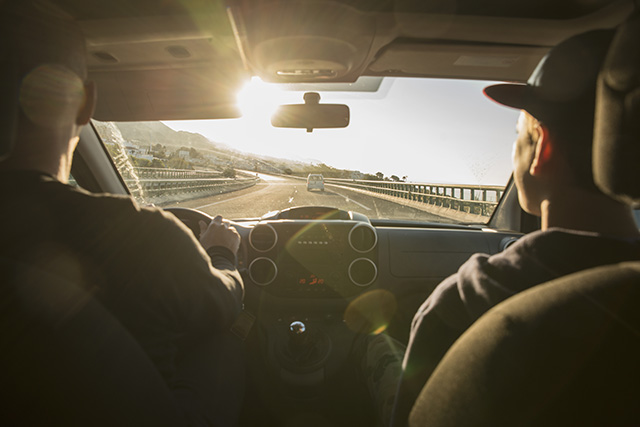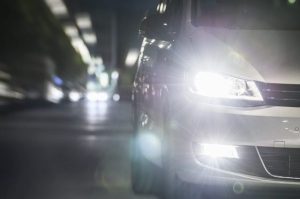We’ve all been there before: driving home after work and being blinded by the setting sun. You squint, turn the sun visor down and try to peer through the windshield just to get a glimpse of the road. Truth be told, this is more than just a seasonal annoyance, it can be a serious safety risk.
Just after sunrise and before sunset, the sun can shine directly into a driver’s eyes. The glare can make it much more difficult to see the road ahead, as well as other cars, pedestrians and hazards. While the sun will continue to rise and set, there are some helpful tips to dealing with the glare when driving during these times of the day.
Keep Your Windshield Clean
Your windshield provides your view of the road, so any dirt, debris or smudge can limit your field of vision. This situation is exacerbated during sunrise and sunset. When the sun hits your windshield during this time of day, it highlights all the dirt and smudges on the glass – even those you didn’t know were there. Now, you don’t have to just deal with seeing past the sunlight, but also all the dirt on your windshield. This could create a serious safety risk.
Fortunately, there is an easy way to prevent this: keep your windshield clean. You don’t need to do a thorough wash everyday, just a quick clean once a week should do the trick. And remember to clean both the outside and inside of the glass. A professional-grade product will give you the best results.
Turn on Your Headlights
It may seem counterintuitive to turn your headlights while the sun is up. But this tip is not necessarily just for you, it’s to help your fellow drivers. If your headlights are on, so are your taillights, making it easier for the car behind you to see your vehicle. If they can see your car, they’ll be less likely to cause a crash, creating a safer roadway for everyone.
Make sure that your lights are clean. These lights can get cloudy and dirty, creating a much dimmer light.
Break Out the Shades
No reason to reinvent the wheel. If the sun is in your eyes, put on a pair of sunglasses. It’s a great idea to always have a pair stored in your car. You never know when the clouds will part while you’re driving. Ideally, you’ll want to use polarized sunglasses, which have a special chemical applied to the lenses that filter light. The result is a clearer picture and reduced strain on your eyes.
Drivers can also utilize the vehicle’s sun visor. Depending on the location of the sun, the visor may be able to completely block it out.

Drive Slow
The goal of beating sun glare is to get from one place to another safely. So while driving slowly won’t help get the sun out of your eyes, it will help you drive during sunrise and sunset.
Driving at a safe speed is always important regardless of the circumstances, but is even more critical when your vision may be compromised. The slow speed gives you more time to observe the vehicle in front of you, scan the road, watch for hazards and pedestrians, and make any adjustments.
Leave Extra Room
It doesn’t matter how slow you’re driving – if you don’t leave enough room between your vehicle and the other cars on the road you’re more likely to cause a crash, particularly in low visibility. In fact, limited light can negatively affect depth perception. Make sure to give yourself plenty of space to react and maneuver.
Adjust Your Driving Routine
If you’re forced to deal with sun glare on a regular basis, you may want to consider altering your driving schedule if possible. After all, you don’t have to fight sun glare if you don’t have to face it. Are you able to start your trip a few minutes earlier or later? If so, this may help alleviate the problem.
You may instead be able to adjust your route. Although you’ll likely need to travel in the same direction, you may be able to find a different route that has tall buildings or trees that will help block out the sun.
Pull Over
If you can’t drive safely, don’t drive at all. When you find yourself fighting a losing a battle against sun glare, do the right thing and pull over. Find a safe spot, ideally in a parking lot and wait for the sun to move. It may only take a few minutes for the sun to get out of your direct line of sight and allow you to properly see the road.
Following these tips to avoid glare are important for keeping your view of the road clear when driving. If there is something more obstructive such as a crack or chip in your windshield, make sure to have it fixed as soon as possible.
Get more car safety tips.
43 Thoughts on “Tips for Avoiding Glare When Driving”
Leave A Comment
Comments are subject to moderation and may or may not be published at the editor’s discretion. Only comments that are relevant to the article and add value to the Your AAA community will be considered. Comments may be edited for clarity and length.
















Why do they allow those terrible blinding headlights. Why dont people protest. These lights are so dangerous. For years when you had your bright lights when a car approached you had to switch from your high beams to the regular beams.
Drive slow and leave extra room are two great pieces of advice for dealing with glare and driving in general. It’s too bad that many aggressive drivers don’t respect these practices. Ultimately it’s everyone’s roads, not their roads. If they don’t like it, then maybe they should let someone else do the driving.
Regarding the night glare from oncoming traffic, I find concentrating on looking at the white line on the right-hand side of the road is tremendously helpful. I think I might have learned this trick from one of those AAA classes!
I frequently drive just before sunset when the sunlight aims at my face. I bought a sunscreen that attaches to my sun visor. I can easily flip the screen down and cut the glare.
I agree with Richard. I would go even further. Halogen headlights, even when not on high beam, are blinding for oncoming traffic. What can we do to avoid being blinded at night when sunglasses, visors, etc. are obviously of no help against superbright headlights?
headlite glare at night
What I really need to know is what to do about glare at night. Modern headlights are amazing as far as lighting up the road but it comes at the expense of blinding everyone else. Driving on a rainy night on back roads with no painted lines is almost impossible. Especially when so many don’t understand the courtesy of dimming the brights when traffic is oncoming. I think auto manufacturers have a responsibility here but in the meantime what is the next best solution?
I have yellow-tinted glasses that help cut headlight glare a lot. If you already wear glasses, large-size ones that fit over your glasses are available.
I found a baseball cap with brim was also helpful. I could turn the brim in the direction of the sun and it helped keep the sun out of my eyes.
Thank you for this article. I used to have to drive home from work facing this sun issue every day. I would pull the visor down and sit as tall as possible and on the edge of the seat. It helped somewhat, but it is a very scary thing.
My wife and I both have sensitive eyes and I find that sunglasses don’t work well enough at sunset (we are late risers so we don’t deal with sunrise) so I went and bought welding glasses on Amazon for $20. These are not good to wear at times other than bright blinding sun, but they are amazing when you are blinded. Bollé Safety 253-TR-40089 Tracker Safety Eyewear with Black/Gray Polycarbonate + TPE Full Frame and Welding Lens
I could use some safety tips for encountering oncoming cars with halogen headlights after dark. I live with hills & curving roads and the glare from those lights can be blinding. Safe for that driver but not for me.
To eliminate glare completely, I have used my product idea which was rejected for whatever reason from the patent and/or copyright office years ago. Since then, have used it successfully and have not dismissed it from the top of my dashboard, 24/seven. For weight so it doesn’t move, I placed 2 layers of dull black felt on top of my dashboard, drivers side portion. This eliminates 100% of glare, guaranteed! I submitted my idea to a company not to long ago but the cost of continuing is something I could not afford since Covid hit us and not receiving an income for 2 years. Anyway, this product could be designed for any vehicle through laser technology and made to order with additions to insure stability.
It was mentioned in the article that when your headlights are on so are your taillights. We take many road trips. Over the years we have noticed an increase in the number of cars with headlights on and no taillights on.
They don’t have their headlights on, only their cruising lights. Many people make the mistake of thinking that cruising lights are enough when it rains. However, the headlights need to be on so that the rear lights are also on.
Totally agree, the new headlights are blinding.
There is a petition and a move afoot aimed at headlight manufacturers. It is NOT just our sun… it is the light of a thousand suns coming at us from the other cars – either behind or ahead of us, especially SUVs and trucks. I hope AAA can get involved in this problem as it is getting worse. I hate driving at NIGHT because of this. I know how to avoid the sun’s glare by using the tricks above. But headlights – not just highbeams anymore, are really just horrendous. Something needs to be done.
So true…this must be addressed it’s a major hazard!
I will fully support any petition or movement to reduce the glare of oncoming headlights especially pickup trucks and SUV’s with LED lights. They are much higher than my sedan and it appears that their headlights are not adjusted downward. Their lights blind me at night and I often have to just stop on city streets to let them pass. I would support legislation to get manufacturers to adjust these high-flying headlights. Obviously the drivers of these vehicles love being able to see further than anyone else but it also shows they couldn’t careless about anyone else.
Another neat trick to try when the sun gets in your eyes is to shift one’s entire head or even one’s entire trunk from side to side during difficult viewing intervals. This will show motion on cars and or trucks ahead but much less motion for (more) stationary objects, like the road surface and various objects on the roadsides like trees, bushes, and parked vehicles. Try it. It actually works!
High beams are more dangerous. The sun is constant only varying around curves but opposing headlights, especially from pickups and trucks with weight in the rear lifting the front can be blinding. Have there been any studies on head on collisions or cars run off the road because of blinding from incoming traffic?
Question: I often have glare in my eyes when I turn a corner. It is difficult to see if someone is crossing the street or if a car is coming.
Any suggestions?
I keep a light weight foam visor in my car and wear it in extreme sun conditions when sun glasses and the car visor doesn’t cover the glare. I can pull it straight down or to the left or right to stop being blinded. A real life saver!
My Honda CRV (2009) has the smallest/shortest sun visor ever! I’m tall, but the visor still needs to be at least 3”-4” longer. I’m surprised this vehicle passed safety inspections before they rolled them out. These short visors are incredibly dangerous!!!
Not as well as their manufacturers would tell you.
Will try sunglasses at night as on the Cross Bronx Expy in Queens and crossing the George Washington Bridge headlights from opposite side of highway cars hit you right in the eyes blinding me.
I find my yellow tinted sun glasses (Amazon) are a huge help for oncoming headlights.
Always live east of where you work.
Best comment award ????
Umm, that doesn’t work in the morning, fella! But nice try.
if i live east of where i work then i’m travelling west to work with sun behind me.
Thanks, great suggestion except that would put me on an island!
I wear glasses so I added everything, transition, anti glare and crizal. Ontop of all that i tinted my windows. I admit all this helps but that ultimate glare from the sun cannot be defeated.
HEAVILY TINTED WINDOWS ARE NOT ALLOWED IN NY STATE, YOU WILL NOT PASS A YEARLY SAFETY TEST.. I BOUGHT A POLARIZED SUN GLASSES FROM QVC AND FOUND THEM EXCELLENT IN THE MORNING.. BY THE WAY IF YOU HAVE CATARACTS IT MAKES THE GLARE WORSE…
Do amber tinted glasses help?
The electrochromic technology already exists to solve this problem. It’s a light-sensitive automatic color conversion smart window. It can control the intensity of sunlight passing through it. The issue for the auto industry is cost/
I wonder if some organization comprised of drivers/consumers could help make this a reality in every new car in the next few years?
Great tips for safe driving!
Since, as you stated, the sun will rise and set each day. Why can’t the car manufacturers come up with a solution? I’ve often thought of a kind of shade. It’s not always convenient to pull over and wait for the sun to rise or set if you are headed east or west.
I purchased a sun visor from Bell & Howell. It would have worked if I was three inches taller. I’m fine too in the woods right at the top of my eyebrows, didn’t help
Me too.
Check out the Vermont Country Store catalogue. They have two cushions that are 3 or 3 1/2 inches thick that help
Yes!!!! Science and engineering can get rockets, drones, telescopes, people, etc. to the Moon and Mars but no one can figure out how to solve the sun glare problem. I always have sunglasses ready and I uses them, and have been blinded several times by sun glare, and by headlights at night.